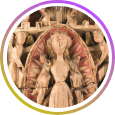"Caliphate marble capital, Umayyad period (950-980 AD)". This capital is undoubtedly from the Caliphate chronology, which is fully in line with those from the time of al-Hakam and al-Hakam II. It is of a composite type and is carved in white marble. Its cylindrical calatos presents two acanthus crowns, the upper one well preserved and the lower one somewhat less well preserved. It has a "lace" decoration, characteristic of Caliphate period productions, with a deep carving of the trephine. The veining of the acanthus leaves in the second row is very well defined, acting as the backbone of the drawing of the leaves, symmetrical and naturalistic. From the lower acanthus some peduncles are born that open when reaching the area of the talus into a tripetalous flower, most probably jasmine. The talus is very well defined, decorated with a chain composed of two circular elements and one ovoid that alternate around the entire contour. The horse goes in a quarter circle decorated with four tripetal plant elements in the form of a candelabra, included under arches formed by doubly forked plant motifs at the crown. The volutes are discoidal, covered on their entire surface by a decoration of intertwined vegetable stems. The volutes are formed by a foliate stem that frames a flower nestled within the whorl. The outline of the volutes is covered by a vertical composition of pentapetalous flowers, possibly lilies. The abacus appears smooth, without inscription, supported on top of the volutes by smooth curved palmettes, with prismatic cartouches on each face except for the outlined one, with floral decoration in the same way as on the equine one. To support the roofs of buildings, the Islamic East of the first centuries sometimes resorted to columns, in countries with a Mediterranean tradition, and other times to pillars, in Mesopotamia, but not systematically. In al-Andalus, the hypostyle architecture was almost exclusively chosen for religious and civil buildings, perhaps to echo the architecture of the Greater Mosque of the Umayyads in Damascus, but undoubtedly also because columns and capitals abounded on the Peninsula and in neighboring territories such as the western Maghreb and southern France. Like all Islamic countries, the architects of the first centuries resorted to the materials of transport. In the naves of the Greater Mosque of Córdoba built under the reigns of Abd el-Rahman I and Abd el-Rahman II, most of the capitals are reused from Roman and Visigothic origin. However, in the part added in 836, eleven capitals made at that time are still in situ, to which should be added the four that support the Visigothic models, with quite rigid blades, deeply marked parallel veins and frequent use of the trephine. Many other capitals come from various sites and, while showing a certain fidelity to ancient models, they also illustrate the attempts of sculptors of the transition period to gradually move away from them and denote profuse inventiveness. The Emirate period is undoubtedly the most prolific in the search for new structural types, derived from Corinthian examples and sometimes enriched by secondary motifs of various origins. The capitals of the Caliphate period offer many fewer variants. They use two crowns of eight acanthus leaves, smooth and solid or thorny. The capitals derived from the Corinthian have a third row of four fan-shaped leaves that come out of the central part of the basket and develop into wide angled volutes. The compound capitals, the most numerous, are characterized by a voluminous quarter-shaped fringe, and some developed angled volutes, formed by a strip of leaflets. Bibliography:
The Andalusias from Damascus to Córdoba. Arab World Institute. Junta de Andalucía. Exhibition catalogue. 2001
DODDS DJ Al-Andalus, The Art of Islamic Spain. New York. 1992.
DOMÍNGUEZ PERELA, E. The Hispano-Muslim capitals of the Lázaro Galdiano Museum.
GÓMEZ - MORENO, M. Ars Hispaniae, Universal History of Hispanic Art, Spanish Arab Art Until The Almohads, Mozarabic Art, vol. 3. 1951.
GÓMEZ-MORENO, M. Documented Arab capitals. Al-Andalus 6. 1941.
OCAÑA JIMÉNEZ, M. Capitals dated from the 10th century. Al-Andalus 5.
PAVÓN MALDONADO, B. New Spanish-Muslim capitals in Seville (contribution to the corpus of Spanish-Muslim capitals). Al-Ándalus 31. 1966.
TORRES BALBÁS, L. Caliphate art, in Muslim Spain until the fall of the Caliphate of Córdoba. 5 of History of Spain. Madrid. 1957.
Provenance: Málaga private collection, 70s. 16.5" height
This lot requires export license
 DECORATIVE ARTS
DECORATIVE ARTS
Starting price
28.000 €
duran-app.lot.title_phone_bid
Phone 1:
Phone 2:
Comments:Confirm your maximum bid
At the time of auction we will contact you by phone:
Confirm your maximum bid
Loading…
Conecting with the server
Are you sure you want to buy the lot?
Durán Sala de Arte 2024
Confirm your maximum bid